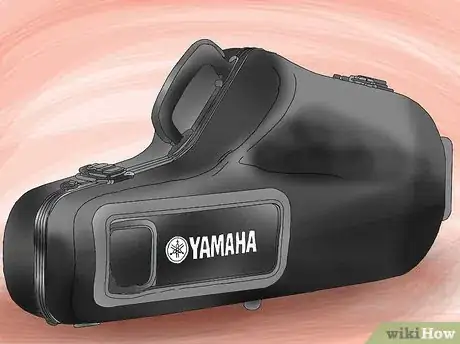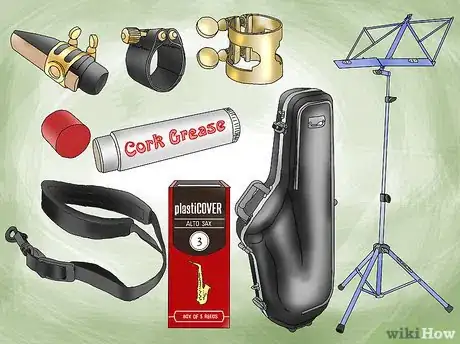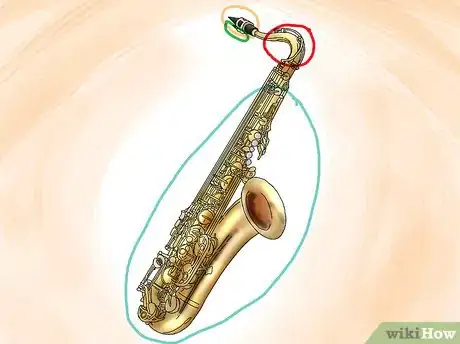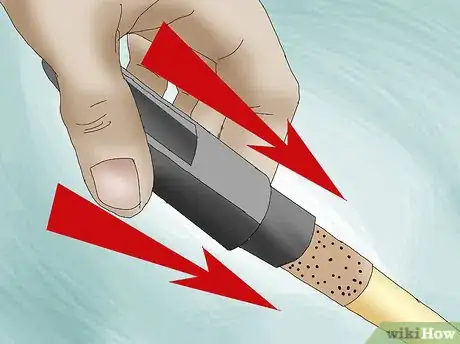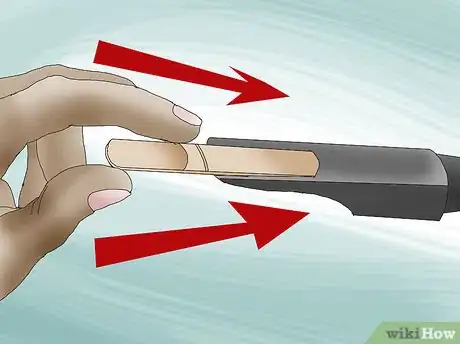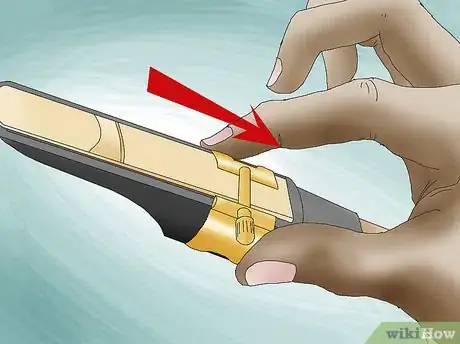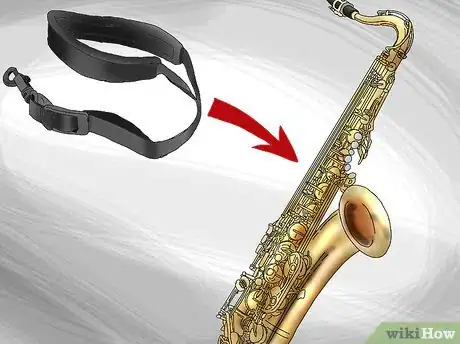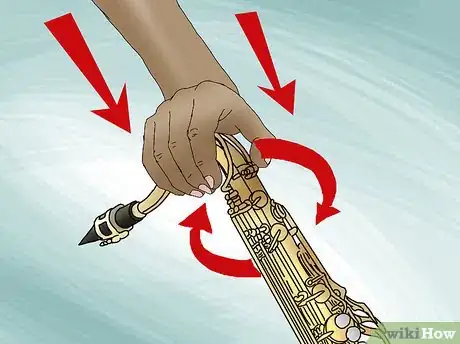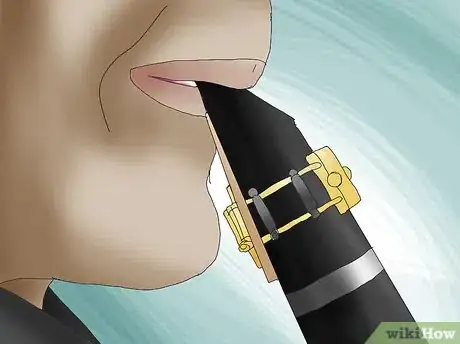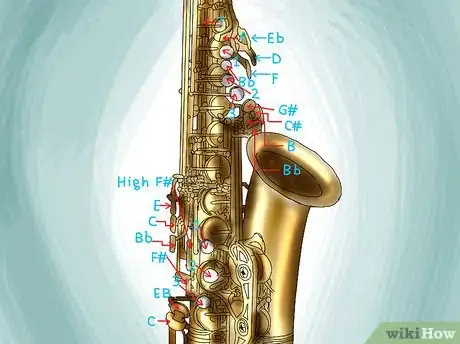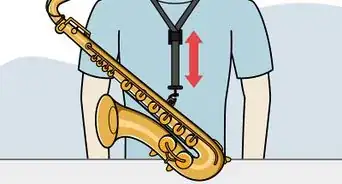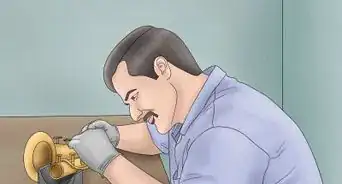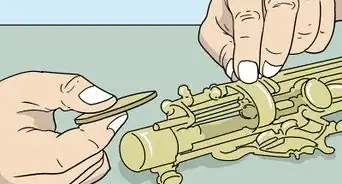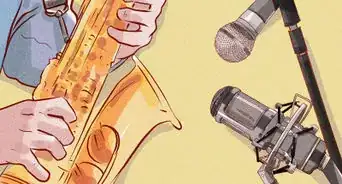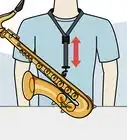This article was co-authored by wikiHow Staff. Our trained team of editors and researchers validate articles for accuracy and comprehensiveness. wikiHow's Content Management Team carefully monitors the work from our editorial staff to ensure that each article is backed by trusted research and meets our high quality standards.
There are 15 references cited in this article, which can be found at the bottom of the page.
This article has been viewed 215,396 times.
Learn more...
The saxophone is an extraordinary instrument capable of producing soothing and sensual music. It's the type of sound that elicits an emotional response from the listener. Learning the woodwind instrument is a dream for many, but the task can seem pretty daunting. Luckily if you get the right equipment and learn the proper technique, getting started with the saxophone is an easily obtainable goal.
Steps
Getting Your Equipment
-
1Decide if you want to buy or rent your sax. If you've never played before, consider your level of dedication and whether you plan on sticking it out for the long run. If you're just curious about the saxophone, then renting one from a reputable music store is cheaper and will ensure that it is in good working condition.[1] However, long-term rental fees can become incredibly expensive, and the condition of a rented saxophone will be worse than buying a new one.[2]
- The price of a new saxophone can range from $300 to over $3,000.[3]
- If you are just starting off with the saxophone, buy a beginner sax that's less expensive before investing in a high-quality sax.
-
2Determine what kind of saxophone you want. An alto or tenor sax are the best options for someone who is new to the saxophone. Alto saxophones are usually the starting point for most beginners because they require less air than the tenor, and have a smaller key scale which makes them easier to handle for young adults or children.[4]
- Tenor saxophones are the most closely associated with jazz music.
- The majority of classic music is written for the alto sax.[5]
Advertisement -
3Purchase or rent a well-known brand from a reputable music store. A damaged saxophone won't produce a good sound and may cost you a lot of money in repairs. Make sure that you choose a reputable music store or saxophone shop in your area when you are looking to buy or rent. Avoid off-brand saxophones because you may have a hard time finding someone who can repair it in the future.
- Some reputable brands include Keilwerth, Yamaha, Selmer, and Guardala.[6]
- If you are still unsure about the brand, reach out to the music store and inquire about brands in your budget.
- If you are purchasing a sax online, make sure there is a return policy or warranty.
-
4Buy the accessories you'll need to play. Other accessories that you'll need are a hard saxophone case, neck strap, extra reeds, cork grease, and music stand.[7] The neck strap supports your horn and keeps it close to your body as you play. Reeds are necessary and can break easily, so it's a good idea to pick up extras. Cork grease is used to help move your mouthpiece on your sax, which will affect its pitch.[8] Finally, the music stand enables you to sit sheet music upright, which is critical when playing a song.
- Music stores will often offer a beginner saxophone with all the accessories included. Ask the salesperson if they offer these types of packages.
Assembling Your Saxophone
-
1Identify all the parts of your saxophone. Before you assemble your saxophone, you need to be able to identify all of the parts. The main parts of the sax are the body, neck, mouthpiece, reed, and ligature.[9]
- Your reed goes in your mouthpiece and is the part of the saxophone you blow into to play it.
- The neck of your sax is the part that connects to the mouthpiece and to the main body of your saxophone.
- The body of your saxophone is the large part that contains all the buttons you hold in order to play different notes.
- The ligature is a metal sheath that fits over your mouthpiece and keeps your reed in place.
- While you assemble your saxophone, refrain from pushing or pulling on parts because they may bend.
-
2Put your reed in your mouth. Your reed needs to be wet when you play the saxophone. As you start to assemble your saxophone, keep your reed in your mouth to put the required moisture on it.[10]
- You can also practice blowing through your reed as you put together your saxophone.
-
3Attach the mouthpiece to the neck of your saxophone. Slide the mouthpiece about halfway over the cork. Make sure that the open side of the neck and mouthpiece are both facing up.[11]
-
4Slide your reed onto your mouthpiece. Gently push the reed onto the mouthpiece, so the top of the reed and the top of the mouthpiece meet each other. It's important that your reed is wet, or it won't hold in place.
-
5Slide the ligature over the reed. Handle the ligature with care and make sure not to damage the tip of your reed. Slide the ligature over the reed and position it towards the bottom of the reed. Tighten the screws to hold the reed in place.[14]
- Once you have the reed attached, you should twist the mouthpiece so the reed is facing downwards.
-
6Attach the body of your sax to your neck strap. Take the body of the saxophone and thread your neck strap through the hook on the back of the saxophone.[15] You should hold the saxophone on the bottom with your dominant hand to keep it in place as you do this.
-
7
Learning How to Play
-
1Hold your saxophone correctly. Your right hand goes on the bottom of the saxophone with your fingers resting on three white buttons. Your thumb sits on a thumb rest closest to you.[18] Your other hand rests on the top of the saxophone with your thumb on the thumb rest and your fingers rest on the three large buttons on the top.[19]
- You will typically have a total of 5 buttons on the top. You rest your fingers on the larger ones or ones that have indents. Skip the very top button, which is usually smaller than the other ones.
- Hold your saxophone close to you so that you have full control over it.
- Practice stretching your fingers to the other buttons on the saxophone to build finger dexterity.
-
2Put your teeth on the top of the reed and curl your bottom lip. Curl your bottom lip over your teeth and put your mouth halfway over the reed. To get the best sound you want to seal your lips to the mouthpiece when you blow.[20]
- Make sure to keep in mind that air can escape from the side of your mouth as well.
-
3Learn the different notes on the saxophone. Notes on a saxophone are comprised of open and closed keys that are performed by holding down buttons on your instrument.[21] If you want to read off sheet music or play with a band, it's important that you study and memorize a key chart, so you know which buttons to hold down.
- A C note is played by holding down the large middle button on the top of your saxophone.[22]
-
4Learn how to read music. To learn classic saxophone music or play with other musicians you'll need to learn sheet music. Sheet music is comprised of notes arranged on five lines called the staff. Sheet music will also designate the register in the form of the treble clef or bass clef, as well as the beats per minute in a song.
- Notes on the lines in higher registers from top to bottom are, F, D, G, B, and E.
- Notes in between the lines in lower registers on the staff from top to bottom are, E, C, A, and F.[23]
-
5Take music lessons or join a band. The best way to learn how to play saxophone is to take lessons from an instructor who can show you how to play. An instructor will be able to teach you music theory and can give you tips on how to improve your personal performance.
-
6Listen to professional saxophone music. To get a better understanding for what your saxophone should sound like, listen to professional saxophone music. The more you listen to different styles of saxophone music, the easier it will be for you play by ear.
- Some of the best sax musicians include Sam Rivers, Joe Henderson, and John Coltrane.[24]
Community Q&A
-
QuestionIs a saxophone harder than a clarinet?
 Community AnswerNo. The saxophone actually lends itself to beginners because you are less likely to squeak. Both instruments, however, are difficult in their own way.
Community AnswerNo. The saxophone actually lends itself to beginners because you are less likely to squeak. Both instruments, however, are difficult in their own way. -
QuestionWill playing the saxophone ruin my tone on the flute?
 Community AnswerIt shouldn't ruin your tone on flute. The most important thing for having good tone is knowing what good tone sounds like. So as long as you're able to create good tone on both instruments and distinguish between the two, you will be fine. There are many people who play both very well. In a big band setting the sax players will play all kinds of woodwind instruments, including flute, and they can sound amazing on all of them.
Community AnswerIt shouldn't ruin your tone on flute. The most important thing for having good tone is knowing what good tone sounds like. So as long as you're able to create good tone on both instruments and distinguish between the two, you will be fine. There are many people who play both very well. In a big band setting the sax players will play all kinds of woodwind instruments, including flute, and they can sound amazing on all of them. -
QuestionWhat's the lowest age you can start playing the saxophone?
 Community AnswerOnce a child is old enough to understand directions and movements (usually around 5 or 6 years old), they should be able to start learning the instrument.
Community AnswerOnce a child is old enough to understand directions and movements (usually around 5 or 6 years old), they should be able to start learning the instrument.
References
- ↑ http://www.beginningsax.com/Sax%20Questions.htm
- ↑ http://thehub.musiciansfriend.com/band-orchestra-buying-guides/saxophone-buying-guide
- ↑ http://www.guitarcenter.com/Saxophones.gc#pageName=category-page&N=18896&Nao=60&recsPerPage=20&v=g&Ns=pLH&postalCode=19019&radius=100&profileCountryCode=US&profileCurrencyCode=USD
- ↑ http://www.childrensmusicworkshop.com/instruments/altosax/
- ↑ http://thehub.musiciansfriend.com/band-orchestra-buying-guides/saxophone-buying-guide
- ↑ http://www.beginningsax.com/Sax%20Questions.htm
- ↑ https://tamingthesaxophone.com/learn-to-play-saxophone
- ↑ https://www.youtube.com/watch?v=9HDKTtPKvNw
- ↑ https://tamingthesaxophone.com/learn-to-play-saxophone
- ↑ https://www.youtube.com/watch?v=00i8MCkFKcI
- ↑ http://www.altosaxophone.us/alto_sax_assembly.html
- ↑ https://www.nickrailmusic.com/t-saxophonecare.aspx
- ↑ http://www.beginningsax.com/Saxophone%20Assembly.pdf
- ↑ https://tamingthesaxophone.com/learn-to-play-saxophone
- ↑ http://www.altosaxophone.us/alto_sax_assembly.html
- ↑ http://www.beginningsax.com/Saxophone%20Assembly.pdf
- ↑ https://www.youtube.com/watch?v=00i8MCkFKcI
- ↑ http://www.altosaxophone.us/blow_and_finger_alto_sax.html
- ↑ https://www.youtube.com/watch?v=00i8MCkFKcI
- ↑ https://www.youtube.com/watch?v=00i8MCkFKcI
- ↑ http://www.amromusic.com/saxophone-fingering-chart
- ↑ https://www.youtube.com/watch?v=DzOdKSuHyw4
- ↑ http://www.musicnotes.com/blog/2014/04/11/how-to-read-sheet-music/
- ↑ https://burningambulance.com/2012/09/14/the-50-greatest-saxophonists-ever-10-1/
About This Article
To play a saxophone, place your dominant hand near the bottom of the saxophone, and your other hand near the top. Each hand will have its fingers resting on three buttons, with its thumb on a thumb rest closest to you. Then, put your teeth on top of the reed and curl your bottom lip. Seal your lips to the mouthpiece when you blow, making sure no air comes out of the sides of your mouth. For more tips on playing a saxophone for beginners, including how to choose and set up a saxophone, read on!


